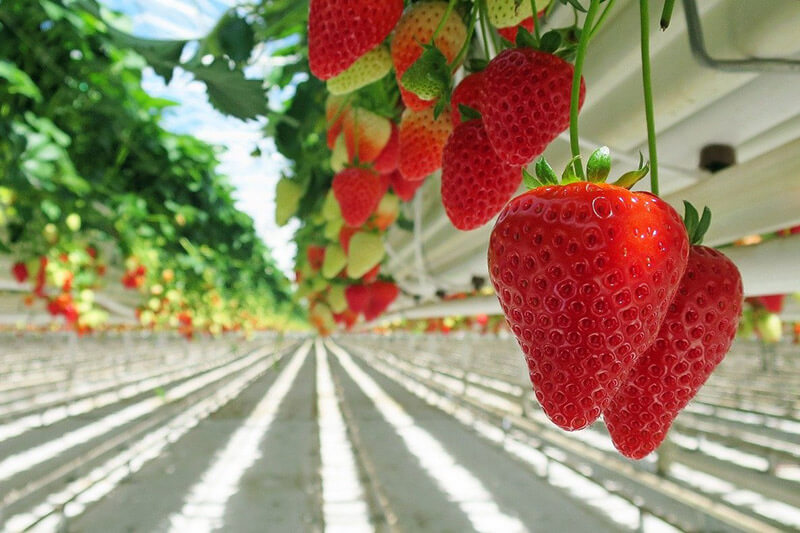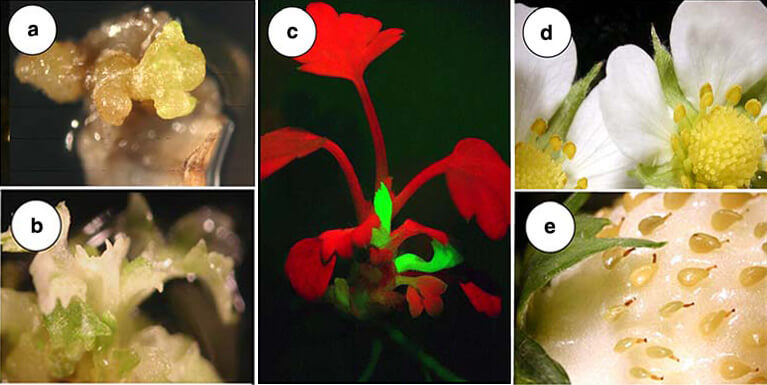Fragaria ananassa Duch., also known as strawberry, is a perennial grass and wood plant originating in South America. It is now widely cultivated in Europe and other places around the world. Strawberry has rich nutritional value and is known as the "Queen of Fruits". It is rich in vitamin C, its content is 7-10 times higher than that of apples and grapes. At the same time, its vitamin A, carotene, tannic acid, aspartic acid, strawberry amine, pectin, folic acid and other nutrients are also 3-4 times higher than apples, pears, and grapes. Eating strawberries can protect eyesight, relieve night blindness, promote gastrointestinal motility, and improve constipation. In order to further increase the yield of strawberries and enrich its nutritional value, Fragaria ananassa Duch. gene editing has been widely used in strawberries agricultural production in recent years. Through genetic modifications, we can improve Fragaria ananassa Duch.'s disease resistance, cold tolerance, drought resistance, fruit size and flavor, as well as help you study gene function.

Lifeasible provides one-stop services, covering all steps including experimental design, vector construction, plasmid transformation, positive transplant screening and characterization of transgenic Fragaria ananassa Duch.. Our various genetic modification services are as follows:
Gene overexpression is an efficient tool for studying gene function. The development and utilization of gene overexpression technology has brought us many conveniences to study gene function and improving the yield of target products. Through the quantitative overexpression of genes related to tannic acid, aspartic acid, strawberry amine and other chemical components in Fragaria ananassa Duch., the production of specific compounds can be increased. We could help our customer overexpress many genes including FaPYL5, a positive regulation gene on strawberry ripening, and FabZIP11, a gene with negative regulation, flower promoting gene FaRGA1, leaf shape control gene FveDDM1, Malate synthesis gene FaMYB73, Anthocyanin synthesis and expression gene FvMYB17, and many other genes related to important traits of Fragaria ananassa Duch.
RNAi is a phenomenon of specific gene silencing mediated by double-stranded RNA (dsRNA) and involved in specific enzymes. It blocks gene expression at the transcription level and translation level. Through RNAi technology, we can achieve silencing of multiple genes in Fragaria ananassa Duch.
Virus induced gene silencing (VIGS) is a genetic technology that induces plant endogenous gene silencing and causes phenotypic changes transiently by infection of viruses with target gene segment. Silencing and functional analysis of target genes in Fragaria ananassa Duch. through VIGS can help our customers save time and obtain valuable information for gene functional analysis. With wealth of experience in VIGS, our scientists can provide you with customized protocol for VIGS in Fragaria ananassa Duch.
CRISPR gene knockout technology is a very powerful and convenient gene editing tool for gene knockout. As a leading company that has been deeply involved in the field of gene editing for many years, we can help you realize Fragaria ananassa Duch. gene knockout in different ways, including frameshift mutations, multiple deletion of fragments, knockout of non-coding genes, knockout of multiple copies of genes, etc.
CRISPR system has strong scalability, which can be used to develop more useful gene editing tools, such as gene knock in. we have developed many methods that can improve gene knock-in efficiency and achieve precise editing of the Fragaria ananassa Duch by increasing the probability of HDR.
CRISPR single base editing technology is a hot area of life science research today. As a company that has been cultivating gene editing technology for decades, Lifeasible could help you achieve the conversion from C to T or A to G in Fragaria ananassa Duch. using CBE and ABE. The dCAS9 is fused to C base deaminase or A base deaminase, which catalyzes the deamination reaction of C or A at a specific position and turns it into U or I. Then it is treated as T or G in the process of DNA replication, realizing the conversion from C to T or A to G.
Sequence-specific control of gene expression on a genome-wide scale is an important approach for understanding gene functions and for engineering genetic regulatory systems. There are many ways to participate in the inhibition of gene expression, one of them is CRISPR Interference (CRISPRi). For the inhibition of Fragaria ananassa Duch. genes, we can provide a variety of solutions, including dCas9 binding to targeted DNA and realizing Inhibition of gene transcription through steric hindrance. In addition, gene knockdown can also be achieved by recruiting a fusion protein to the start site of gene transcription.
CRISPRa technology uses the powerful capabilities of Cas9 and sgRNA to fuse or recruit multiple proteins to enhance gene transcription. For Fragaria ananassa Duch. genes, we provide VPR technology, SAM technology and Suntag technology to allow the CRISPR system to carry more activation element and achieve a stronger activation effect after synergistic amplification.
The study of gene function has always been the core subject of biological research. We provide CRISPR mutation library construction service with high efficiency, short turnaround time, and a low cost. The gene mutation library construction technology we provide for Fragaria ananassa Duch. including gene knockout library construction, gene knockdown library construction, and gene activation library construction. Moreover, single-cell sequencing is available for mutation screening.
DNA-free gene editing technology has received extensive attention from the industry in recent years. We provide DNA free Fragaria ananassa Duch. genome editing services, including transient expression of CRISPR/Cas9 plasmid DNA, in vitro transcription of CRISPR/Cas9, and pre-assembled ribonucleic acid composed of purified Cas9 protein and sgRNAs complex. These technologies can avoid the integration of foreign DNA and genome, and reduce off-target effects. In addition, compared with traditional techniques, these techniques can avoid the use of hybridization or backcrossing to isolate CRISPR/Cas9 chimeras, so they are cheaper and have shorter experimental cycles.
Genetic Transformation Process for Fragaria ananassa Duch.
The most advanced and widely used method for the development of genetically modified Fragaria ananassa Duch. is Agrobacterium-mediated transformation of embryogenic calli.
 Figure 1. Agrobacterium mediated Fragaria ananassa Duch. transformation by infecting embryogenic calli of strawberry and plant regeneration. (a) regenerating transformed callus, (b) transgenic shoot developing from a leaf explant, (c) young transgenic plant, (d) flowers of untransformed (left) and transgenic (right) plants, (e) fruit of a transgenic plant. (Teruko O, et al. 2006)
Figure 1. Agrobacterium mediated Fragaria ananassa Duch. transformation by infecting embryogenic calli of strawberry and plant regeneration. (a) regenerating transformed callus, (b) transgenic shoot developing from a leaf explant, (c) young transgenic plant, (d) flowers of untransformed (left) and transgenic (right) plants, (e) fruit of a transgenic plant. (Teruko O, et al. 2006)
Experts at Lifeasible obtain comprehensive knowledge and years of experience to solve technical problems and challenges in Fragaria ananassa Duch. transformation. We can draw customized solution to help you research on many Fragaria ananassa Duch. varieties. For more information or any inquiry requirements, please contact Lifeasible.
Reference